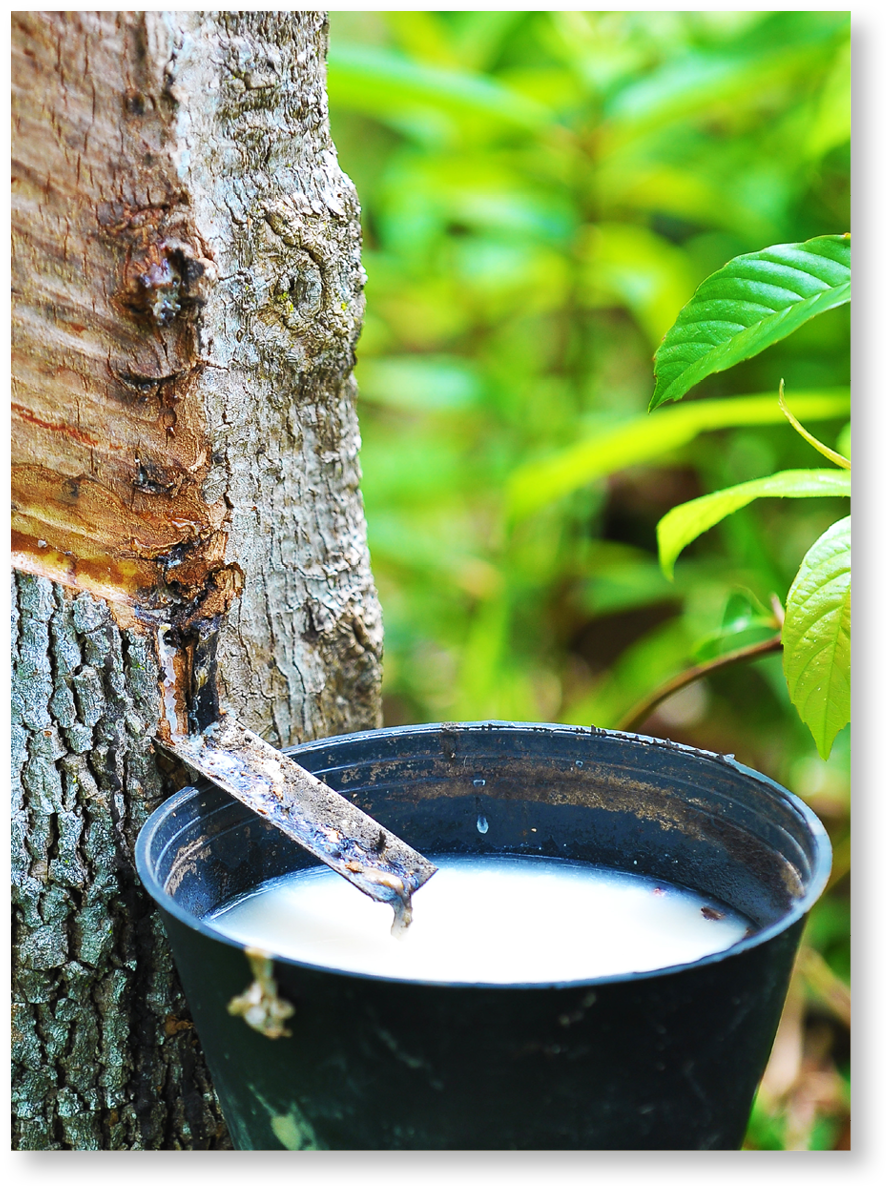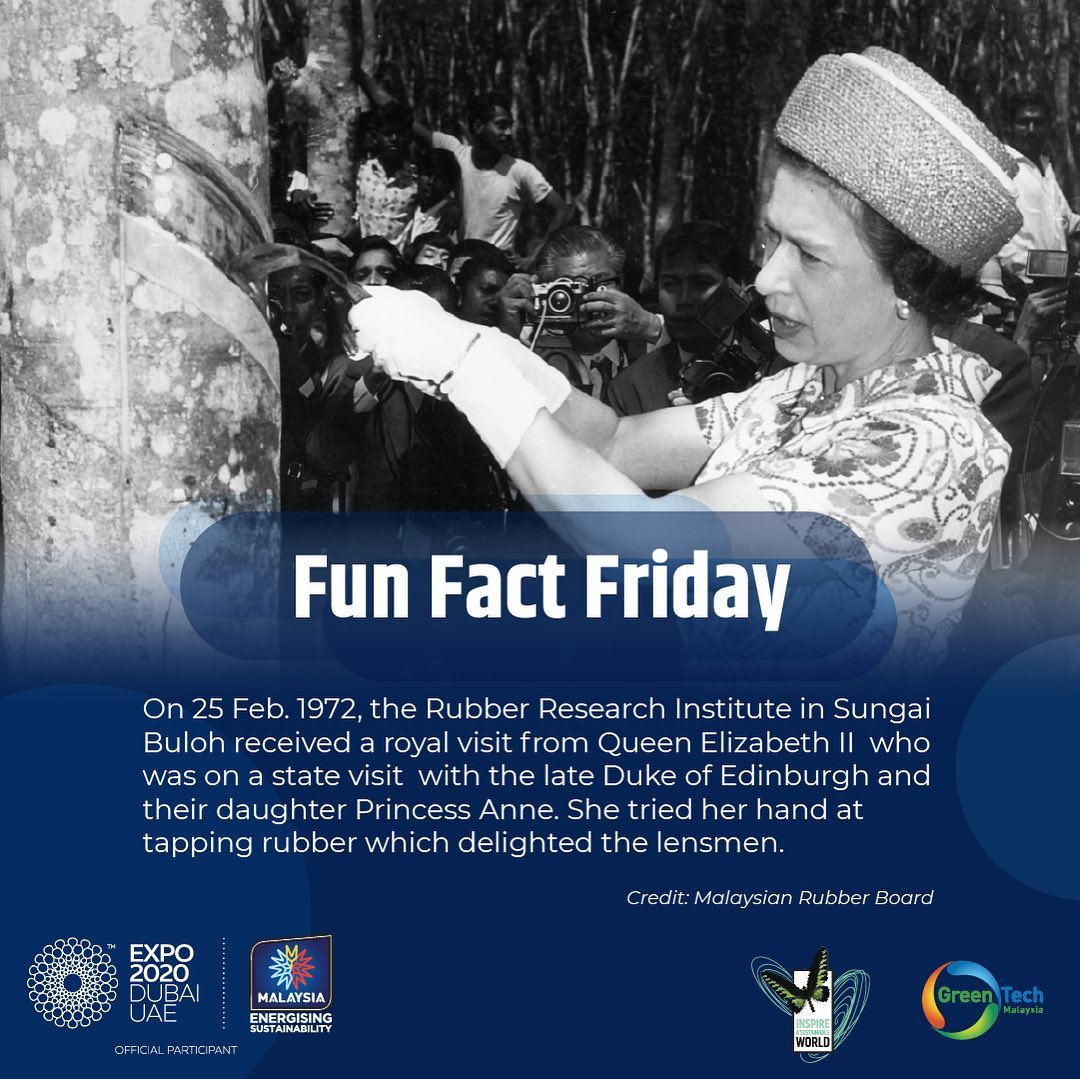Origin and distribution
The tree “Hevea Brasiliensis” is the source of natural latex, the precursor for all subsequent rubber products. It thrives in tropical latitudes, especially in South and Southeast Asia, as well as in West Africa and Central America.
Current production and farmers
In 2020, about 13 million tons of natural rubber (NR) (latex and solid rubber) were produced worldwide. About 40 million people are directly and indirectly dependent on the production of NR. Of particular note is the fact that approximately 90% of the total is produced by smallholder farmers and their families. This makes natural rubber an important factor in the economies of the producing countries, most of which are developing countries.
Expansion of production, sensible?
There are a number of arguments in favor of expanding production in the growing regions. However, before thinking about expanding production, our focus should be on the processing of natural latex in the producing countries.
Processing in the producing countries
Factories in tropical countries use machines that operate on a principle developed in the late 19th century. Consequently, energy consumption is high, and many greenhouse gases are produced during processing.
What is produced in the tree?
The tree produces latex with approx. 30 parts solid rubber and some 70 parts water.
What is happening in a factory?
During processing, part of the crop is concentrated by centrifugation and sold with about 60 parts solid rubber.
The other part is coagulated with acid and a small amount is dried with air or by burning wood with smoke and heat, so called Air Dried Sheets (ADS) and/or Ribbed Smoked Sheets (RSS) are produced. By far the largest quantity is dried in drying ovens by burning kerosene or diesel oil. Large quantities of fossil fuels are required. Solar energy is only used to a very small extent.
How to obtain a saleable product?
To obtain a saleable product, there are essentially two problems to be solved in rubber processing. Primarily, a granulate has to be produced, which must then be dried in a second step. First, the raw product of the tree, the “field latex”, must be turned into rubber granules, demanding various steps, and using large quantities of water. In the second step, the water used must be evaporated again.
How much fossil energy is used to produce exportable natural rubber in a factory? How much CO2 is released?
Exact figures are not available. Assuming that 11 million tons are produced as solid rubber, it can be estimated that approx. 1.8 – 2 million tons of water have to be evaporated. Since the fuels and drying systems used are very different, only theoretical numbers can be given. Drying natural rubber requires approx. 800 MJ per kg. Using the figures mentioned in the literature, 200,000 t of diesel oil would theoretically be required, a process which emits approx. 530,000 t of CO2 into the atmosphere when burned.
How much CO2 do trees remove from the atmosphere?
The trees need CO<sub>2</sub> to grow and produce natural latex. With an estimated cultivation area of about 14 million hectares worldwide, this results in a CO<sub>2</sub> consumption of about 180 million tons per year. In addition, this translates into a release of about 130 million tons of oxygen.
CO2 sinner: synthetic rubber
By contrast, the production of synthetic rubber from crude oil derivatives is polluting the environment with CO2.
What are cup lumps and how are they processed?
Cup lumps happen to be the result of natural coagulation of field latex in the tapping cup on the tree. The further processing of the cup lumps in developing countries is carried out in smaller or larger – mostly privately owned – factories.
Is there a will for change and improvement?
The owners of these factories can only be persuaded to change the traditional system of rubber processing if they see the advantages based on a pilot project. Only then can precise values and data be collected that can later be used as a basis for scaling-up production.
Are machines and processes available to improve production?
In order to save energy and increase efficiency, modern machines are available that double the performance with the same power consumption. Introducing them is a priority. For the implementation of such a project – the conversion of an existing natural rubber factory, only a relatively small investment is required. The amount of such an investment depends largely on the local conditions and which machines need to be modernized.

What we do
UMW Hoffmann Export Import Consulting has been advising both producers and consumers of natural rubber worldwide since 1993. We have advised for almost thirty years primarily in Southeast Asia, Germany, and the USA, and looked after more than a dozen satisfied customers there.
What are our strengths?
A great deal of specialized know-how is required for both the use of natural rubber and the production of natural rubber.
Producers
We advise producers on how to optimize their production. We also create concepts for increasing efficiency – especially for energy saving and accelerated production processes.
ISO 9001 certification is an important step for producers. It provides them with the basis for broadening their customer base.
Consumers
We are in regular contact with well-known consumers in OECD countries and exchange information on the latest developments in the processing of natural rubber into intermediate and finished products.
Production
This important raw material has been used for more than 200 years. The first figures on exports from Brazil date back to 1827, when 31 tonnes were exported. Total production in 2020 stood at about 13 million tonnes.
Production methods
The production methods have changed very little until today. Using modern machinery to save energy and reduce CO2 emissions is the challenge of our time.
ISO 9001 certification is an important first step for producers. In doing so, they create the basis for expanding their customer base.
We give advice on the modernization of your natural rubber production.
Benefit from over 70 years of knowledge in this field.

About us
Questions for the person responsible for the consulting business

Ulrich M. Hoffmann
Where does your enthusiasm for natural rubber come from?
Ever since I studied chemistry in Berlin in the 1950s, the subject of natural rubber, chemically, physically, and technically, has been a constant in my professional life. Especially after 1970, when the natural rubber department for the Hamburg trading company Weber & Schaer was being modernized, I was regularly in the producing countries. There I worked with producers, research institutions (Rubber Research Institutes), and national and international funding institutions to promote the development of markets for special types of rubber. Of course, this required and requires very close cooperation with consumers in the processing industry.
Which experiences are specifically significant for the industry?
Quality and reliability are the most important criteria for a successful producer. The brand name of a factory, together with the necessary certifications, guarantees stable and lasting sales opportunities worldwide. In addition, one needs to regularly exchange with consumers about their outlook and their demand for new types of rubber.
How can the customers of UMW Hoffmann GmbH benefit from this experience?
We can help with the following issues
- Modernization of rubber factories
- Process optimization
- Improving energy efficiency
- Speed up production
- Production of new types of rubber
- Development of new markets
- Support for listing with large consumers in OECD countries
- Extension of the product range
- Definition of options based your raw material base
- Assessment of opportunities and risks in the conversion or expansion of production
- Informing potential consumers about availability and quality
- Approval as a qualified supplier by consumers
- Advice on the selection of machines in production and in the laboratory
- Renewal of machinery
- Procurement of new and used machines
Interesting facts
Interesting YouTube Videos:


Contact



